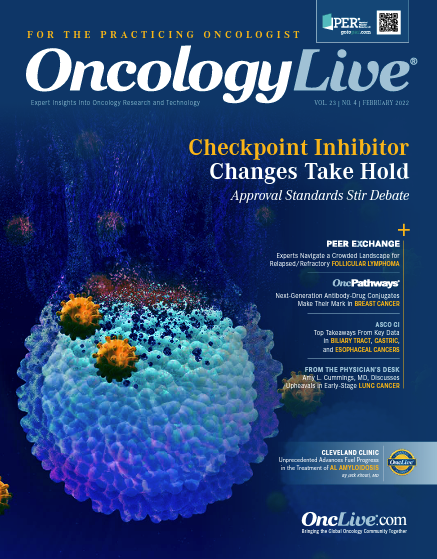Efforts to Target NRG1 Unlock New Pathways for Treatment
Early data have demonstrated poor outcomes for patients with NRG1 fusions, and limited efficacy with available treatments represents a need for the development of novel therapeutic agents.
Janakiraman Subramanian, MD, MPH

The advent and implementation of advanced sequencing technologies in clinical practice have aided in the identification of highly active oncogenic gene fusions. RNA sequencing has illuminated the presence of NRG1 fusions, which, though rare, play a role in the activation of the ERBB pathway. Early data have demonstrated poor outcomes for patients with NRG1 fusions, and limited efficacy with available treatments represents a need for the development of novel therapeutic agents.
NRG1 fusions have been identified in several solid tumor types, including in patients with gallbladder, pancreatic, ovarian, breast, lung, bladder, and colorectal cancers, as well as sarcomas.1
“[NRG1 fusions are seen] across a variety of solid tumors, but overall, the frequency is anywhere between 0.2% and 0.4%,” Janakiraman Subramanian, MD, MPH, said in a recent “Molecular Targets on the Horizon in Non–Small Cell Lung Cancer” OncLive® Scientific Interchange & Workshop panel discussion. “We’ve known about NRG1 fusions for years. They were initially detected in a lung adenocarcinoma by RNA sequencing, and the upstream partner for NRG1 that was originally detected was CD74; it’s a rare fusion in lung cancer.” Subramanian is director of thoracic oncology at Saint Luke’s Cancer Institute and an assistant professor of medicine at the University of Missouri–Kansas City.
Uncovering the Population with NRG1 Fusions
The NRG1 gene represents a unique cancer driver, encoding the neuregulin 1 protein, which functions as a ligand for HER3 and HER4.2-4 Although the fusion is rare among patients with lung adenocarcinomas, with an overall frequency of approximately 1.7%, Subramanian noted that a higher prevalence, ranging from approximately 27% to 31%, occurs in patients with invasive mucinous adenocarcinomas, particularly those with wild-type KRAS disease.5
A growing body of evidence supports the development of novel therapeutic strategies for patients with NRG1 fusions. “The clinical characteristics and response to traditional treatments have been essentially based on case reports until very recently, when we have [had] more updated data from the NRG1 registry,” Subramanian said.
According to an analysis of data from the eNRGy1 Global Multicenter Registry, investigators concluded that NRG1 fusion–positive lung cancers were “molecularly, pathologically, and clinically more heterogenous than previously recognized” and “the activity of cytotoxic, immune, and targeted therapies was disappointing” among patients with rearranged tumor biology.6
In the data, investigators conducted an analysis of the activity of systemic therapy for patients with confirmed NRG1 fusion–positive lung cancer who were treated with platinum doublet– based chemotherapy (n = 15), taxane-based chemotherapy (n = 7), combination chemotherapy/immunotherapy (n = 9), single-agent immunotherapy (n = 5), and targeted therapy with afatinib (Gilotrif; n = 20).3 The median progression-free survival (PFS) was 5.8 months (95% CI, 2.2-9.8), 4.0 months (95% CI, 0.8-5.3), 3.3 months (95% CI, 1.4-6.3), 3.6 months (95% CI, 0.9-undefined), and 2.8 months (95% CI, 1.9-4.3), respectively.
In terms of best response, 25% (5 of 20) of patients who received afatinib had a partial response compared with 13% (n = 2 of 15) of those who received platinum doubletbased chemotherapy, 14% (n = 1 of 7) of those who received taxane-based chemotherapy, and 20% (n = 1 of 5) of those who received singleagent immunotherapy. No complete or partial responses were recorded among the 9 patients who received combination chemotherapy/immunotherapy; however 44% had stable disease.6
“As we can see, [results are] very depressing in terms of traditional treatments, [whether] platinum-based chemotherapy, second-line taxane, or a combination of chemoimmunotherapy,” Subramanian said. “Even where the response rates look relatively good, the median PFS and the CIs [and] the overall duration of benefit do not appear to be great for this population.”
Building a Future for NRG1
Subramanian highlighted an important finding from the study—the prevalence of NRG1 fusions outside patients with mucinous adenocarcinomas. “There were several patients with squamous cell carcinomas of the lung as well as large cell histology [who had] an NRG1 fusion, the bottom line being that we should be testing all these patients and not necessarily focusing on an enriched population.”
One such effort to develop a novel treatment for this patient population is the phase 2 CRESTONE trial (NCT04383210). Investigators are evaluating the efficacy of a novel HER3targeted monoclonal antibody, seribantumab, in patients with advanced solid tumors with NRG1 fusions who have progressed after 1 or more prior lines of therapy.7
“HER3 is a truncated protein,” Subramanian said. “It does not have its own kinase, but it heterodimerizes with HER2 after it is activated by NRG1, [leading] to downstream pathway activation through PI3K/AKT pathway.” In preclinical models, seribantumab, a fully human IgG2 monoclonal antibody against HER3, has demonstrated the ability to block HER3-HER2 dimerization and downstream signaling, as well as block the ligand-dependent activation and phosphorylation of HER3.8
In CRESTONE, patients with NRG1 fusion-positive tumors—as determined by local clinical laboratory improvement amendments or a similarly accredited lab—who have received no prior treatment with pan-ERBB–, HER2-, or HER3-targeted therapy and who have no other actionable molecular alterations are eligible for enrollment.7 Eligible patients will receive 3 g of seribantumab intravenously over 1 hour weekly. The primary outcome in the intention-to-treat population is objective response rate per RECIST 1.1 criteria by independent central radiologic review. Secondary end points include duration of response, safety, PFS, overall survival, and clinical benefit rate.
Integrating Testing into Practice Is a Top Priority
Outside clinical trials, Paul A. Bunn Jr, MD, who served as moderator for the OncLive® program, noted that actionable treatments will rely on the identification of these fusions through testing in clinical practice. Bunn is a 2014 Giants of Cancer Care® award winner in the lung cancer category, the James Dudley Chair in Cancer Research, and distinguished professor of medicine–medical oncology at the University of Colorado School of Medicine in Aurora.
Bunn cited data from the 2021 American Society of Clinical Oncology Meeting that showed that rates of testing for mutations in community practice are low. Specifically, results showed that among 3474 adults with non–small cell lung cancer (NSCLC), 90% underwent testing for 1 biomarker, but less than half (46%) received testing for 5 actionable mutations, including ALK, BRAF, EGFR, ROS1, and PD-L1.8
He posed the question: “[Because NRG1] is detected by RNA sequencing, what do you think should be the standard testing? Do you believe everybody should have RNA and DNA testing, or should people have selective testing?”
Subramanian said that as investigators continue to evaluate the efficacy of novel NRG1-targeted agents, awareness will play a large role in the community setting in terms of integrating testing as standard practice. “My personal opinion is that we should be testing everybody, and we should be using both DNA and RNA,” he said. “[Data from] the NRG1 registry show that in approximately 75% of patients with NRG1 fusions, they were detected by an RNA sequencing platform; approximately 25% DNA-based deduction was reported.” He added that RNA sequencing–based deduction combined with DNA-based deduction appears to provide the highest likelihood of detecting NRG1 fusions.
Subramanian concluded that testing is particularly important among patients with NSCLC. “We can see that NRG1 fusions are not necessarily specific to 1 subtype of NSCLC. It’s a little bit more diverse across the histologic subtypes, and we see that standard-of-care treatments for these patients—chemotherapy, immunotherapy, or even afatinib—do not hold a lot of promise. Identifying this fusion and, hopefully, having available either a [tyrosine kinase inhibitor] or a monoclonal antibody might be the best option for these patients.”
Room for optimism exists in the community setting, said Subramanian, who added, “We interact with a lot of colleagues in the community, and there is awareness that molecular testing is important. The problem is for a busy community oncologist who is seeing 20 to 30 patients—they are not chasing after testing….Promoting testing and making sure it gets incorporated with an [electronic medical record] would be key [to ensure] ordering and testing can be done far more easily for these busy clinicians.”
References
- Jonna S, Feldman R, Ou SHI, et al. Characterization of NRG1 gene fusion events in solid tumors. J Clin Oncol. 2020;38(suppl 15):3113. doi:10.1200/JCO.2020.38.15_suppl.3113
- Russo A, Lopes AR, Scilla K, et al. NTRK and NRG1 gene fusions in advanced non-small cell lung cancer (NSCLC). Precis Cancer Med. 2020;3:14. doi:10.21037/pcm.2020.03.02
- Bendell JC, Lim KH, Burkard ME, et al. CRESTONE: clinical study of response to seribantumab in tumors with neuregulin-1 (NRG1) fusions—a phase II study of the anti-HER3 mAb for advanced or metastatic solid tumors (NCT04383210). J Clin Oncol. 2021;39(suppl 3):TPS449. doi:10.1200/JCO.2021.39.3_suppl.TPS449
- Russo A, Lopes AR, Scilla K, et al. NTRK and NRG1 gene fusions in advanced non-small cell lung cancer (NSCLC). Precis Cancer Med. 2020;3:14. doi:10.21037/pcm.2020.03.02
- Drilon A, Somwar R, Mangatt BP, et al. Response to ERBB3-directed targeted therapy in NRG1-rearranged cancers. Cancer Discov. 2018;8(6):686-695. doi:10.1158/2159-8290.CD-17-1004
- Drilon A, Duruisseaux M, Han JY, et al. Clinicopathologic features and response to therapy of NRG1 fusion–driven lung cancers: the eNRGy1 Global Multicenter Registry. J Clin Oncol. 2021;39(25):2791-2802. doi:10.1200/JCO.20.03307
- Study of seribantumab in adult patients with NRG1 gene fusion positive advanced solid tumors. ClinicalTrials.gov. Updated December 14, 2021. Accessed January 10, 2022. https://www.clinicaltrials.gov/ct2/show/NCT04383210
- Robert NJ, Nwokeji ED, Espirito JL, et al. Biomarker tissue journey among patients (pts) with untreated metastatic non-small cell lung cancer (mNSCLC) in the U.S. Oncology Network community practices. J Clin Oncol. 2021;39(suppl 15):9004. doi:10.1200/JCO.2021.39.15_suppl.9004




